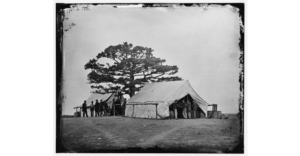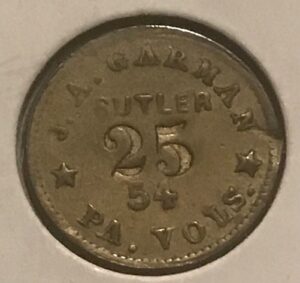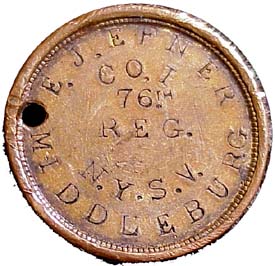By Mike Barhorst

August 1863.
Although Union and Confederate soldiers were divided on nearly every topic, they could agree on at least one
thing – the fact that the camp sutler was at best, a necessary evil. Sutlers were civilian merchants, camp-
followers who sold goods at high prices to soldiers while they were in the field or in camp.
Sutlers operated under a special appointment – usually from the regimental commander, occasionally
from the governor of the state from which the unit originated and occasionally, as a result of the
recommendation of the regiment’s commissioned officers. The prices sutlers charged were initially set
by a committee of officers from the unit the sutler served.
At the beginning of the war, privates in both the Union and Confederate Armies were paid $11 per month. In
addition, they were provided such items as rations, uniforms, weapons and ammunition, blankets and tents.
Unfortunately, there was a whole lot the armies did not provide, including basics such as soap. That’s why
sutlers were essential.
Weekly rations consisted of hardtack, flour, potatoes, beans, rice, meat, coffee, sugar, vinegar and salt.
Unfortunately, it was often the case that the meat was spoiled and the hardtack was infested with worms.
When that happened, the soldiers had little choice but to purchase supplies from the sutler if they wanted to
eat.
The wares sutlers sold included all types of goods not provided by the government. In addition, they also sold
goods that were provided by Uncle Sam but would either fail to arrive when they were needed or be
spoiled/ruined when issued. Sutlers had no competition because peddlers were not allowed in the camps. As a
result, the soldiers either paid the exorbitant prices charged by the sutler or did without the goods they desired.
If soldiers were near a town, they were often allowed to go into the town to purchase goods from both the local
merchants and the inhabitants of the town. If the commanding officer refused to allow the soldiers to go into the
town, some soldiers were so desperate that they would slip out of camp and then return later with the desired
supplies. Of course, the sutlers would generally protest over the loss of business in such cases, but they knew
that the commanding officer was within his jurisdiction to allow the soldiers to go on leave, so did not protest
too vigorously.

amounts. The token pictured is good for 25 cents in merchandise. Such tokens generally had a patriotic emblem on one side (Washington, Lincoln, the Bald Eagle and the Flag were popular) and the obverse side had the name of the sutler, the military unit, and the amount. For example, Garman issued tokens in other amounts including both three and 10 cent denominations.
Sutlers sold such items as soap, needles and thread, combs, razors, tin plates and cups, canned meats, eggs, butter, potatoes, fruit, ginger ale, newspapers, writing paper, pens and ink, books and tobacco. Although it was illegal for sutlers to sell alcohol, many did. For a variety of reasons (including the war itself), the military oversight of sutlers that existed on paper simply didn’t exist in reality. It was not uncommon for soldiers to be dissatisfied with the quality of the merchandise sold by the sutlers. If they were not dissatisfied with the quality of the products purchased, they were certainly dissatisfied with the prices charged. In addition, the scales used to weigh produce were often ‘balanced’; in favor of the sutler. In most cases, the soldiers were forced to purchase tokens that were only good at the sutler’s “store” (see the attached photo).
If soldiers were purchasing items on credit, military law forbade sutlers to allow a soldier to purchase more merchandise during the course of the month than a third of the soldier’s monthly pay. On the day of the month that pay was issued, the sutlers collected directly from the paymaster, guaranteeing that they received the funds they were due.
It was not uncommon for a sutler to make a profit of 300% or more. In most units, the sutler’s profits were
‘taxed,’; and the funds collected used for such essentials as purchasing music for the band, purchasing books
for the unit’s library, and helping the families back home of those who were killed or seriously wounded. Some
unscrupulous officers even kept a share of the sutler’s profits for themselves.
Because profit margins were high, robberies were not uncommon. There were occasions when the troops became so upset with the sutler that they would raid the sutler’s’store’, usually with no interference by superior officers, who were paying the same exorbitant prices as the enlisted men.
Sutlers held semi-official positions in their units and were subject to orders. The army moved the sutler’s goods
in government wagons. That didn’t sit well with officers who needed the wagons and horses for military
purposes, and had to feed and maintain the horses and keep the wagons in good repair. If fighting with the
enemy broke out, the officers also had the responsibility of moving both the sutlers and their wares to the rear.
As the war wore on, the Union blockade of Confederate ports made it increasingly difficult for Confederate
sutlers to have supplies to sell at any price. Prior to the war, most of the goods consumed in the South were
purchased in the North. As a result, blockade runners provided the available goods, both civilian and military,
that were consumed in the South during the war.
To help alleviate the incessant shortage of supplies and the price gouging of the sutlers, folks both North and
South often sent care packages from home, filled with supplies and baked goods. Unfortunately, many
packages never arrived because troops were so often moving from place to place. Those that did arrive were
delivered so late that the food that was sent was no longer fit for consumption.

One of the great fears haunting soldiers was that they would be killed and their families back home would never
know. Before going into battle, many soldiers would write their name and home town on a piece of paper and
pin it inside their uniform. In the days before dog tags were issued, sutlers saw a potential market and began
selling small round metal discs that were worn by soldiers that included the soldier’s name, unit and home town
(see accompanying photo).Using a small machine that would stamp designs into metal discs made of brass or lead, the sutlers thus created the first dog tags. While very few identification tags for Confederate soldiers have been found, many were purchased by Union soldiers.
Despite the fact that many Union soldiers purchased and wore the identification discs sold by sutlers, it is still estimated that more than 5% of the combined Union and Confederate dead remain unidentified. In fact, of the 325,230 Union soldiers buried in National cemeteries, 148,883 of the graves are marked ‘unknown’.
Despite the fact that most sutlers were despised by the troops they served, the sutler provided a host of essential supplies. Every time the troops moved to a new location, the first question most soldiers asked was the location of the camp so that when they wrote home, they could report on their latest whereabouts. The second question was nearly always the location of the sutler within the camp.
